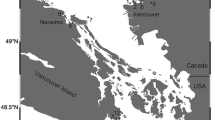Abstract
Ambient sediments were collected from a reference site in the North Edisto River, SC and transferred to a laboratory facility to investigate effects of chemical contaminants on estuarine infaunal communities under controlled mesocosm conditions. Sediment contaminant slurries were prepared using dried sediments collected from the reference site and spiked with a metal (copper), a polycyclic aromatic hydrocarbon (pyrene), and a pesticide (4,4′-dichlorodiphenyltrichloroethane) to yield nominal mean effects range–median (ERM) quotients of <0.01 (no addition), 0.1, and 1.0 and applied to control, low dose (TRT A), and high dose (TRT B) treatment groups, respectively. Sediment samples for contaminant and benthic analyses were collected at the start of the experiment, 1 month after dosing, and 3 months after dosing. Near-nominal mean ERM quotients of 0.001, 0.075, and 0.818 were measured initially after dosing and remained fairly constant throughout the experiment. Measures of benthic condition, diversity, and richness were significantly reduced in both treatment groups relative to the control 1 month after dosing and persisted in TRT B at 3 months. The results demonstrate that benthic community effects can be observed at mean ERM quotients that are about an order of magnitude lower than levels that have been shown to be associated with significant toxicity in acute laboratory bioassays with single species (e.g., amphipods) in other studies.
Similar content being viewed by others
References
Bat, L., Akbulut, M., Culha, M., Gundogdu, A., & Satilmis, H. H. (2000). Effect of temperature on the toxicity of zinc, copper and lead to the freshwater amphipod Gammarus pulex pulex (L., 1758). Turkish Journal of Zoology, 24, 409–415.
Batley, G. E., Stahl, R. G., Babut, M. P., Bott, T. L., Clark, J. R., Field, L. J., et al. (2005). Scientific underpinnings of sediment quality guidelines. In R. J. Wenning, G. E. Batley, C. G. Ingersoll, & D. W. Moore (Eds.), Use of sediment quality guidelines and related tools for the assessment of contaminated sediments (pp. 39–119). Pensacola, FL: SETAC.
Bejarano, A. C., Pennington, P. L., DeLorenzo, M. E., & Chandler, G. T. (2005). Atrazine effects on meiobenthic assemblages of a modular estuarine mesocosm. Marine Pollution Bulletin, 50, 1398–1404.
Boesch, D. F. (1977). Application of numerical classification in ecological investigations of water pollution. Technical Report, United States Environmental Protection Agency, Grant no. R803599-01-1, ROAP/TASK No. 21 BEI, Corvallis Environmental Research Laboratory, Newport, Oregon.
Bray, J. R., & Curtis, J. T. (1957). An ordination of the upland forest communities of southern Wisconsin. Ecological Monographs, 27, 320–349. doi:10.2307/1942268.
Clément, B., Cauzzi, N., Godde, M., & Crozet, K. (2005). Pyrene toxicity to aquatic pelagic and benthic organisms in single-species and microcosm tests. Polycyclic Aromatic Compounds, 25, 271–298. doi:10.1080/10406630591007260.
Dunnett, C. W. (1955). A multiple comparisons procedure for comparing several treatments with a control. Journal of the American Statistical Association, 50, 1096–1121. doi:10.2307/2281208.
Evans, A. D., & Nipper, M. (2007). Toxicity of phenanthrene and lindane mixtures to marine invertebrates. Environmental Toxicology, 22(5), 495–501. doi:10.1002/tox.20279.
Fortner, A. R., Sanders, M., & Lemire, S. W. (1996). Polynuclear aromatic hydrocarbon and trace metal burdens in sediment and the oyster, Crassostrea virginica Gmelin, from two high-salinity estuaries in South Carolina. In F. J. Vernberg, W. B. Vernberg, T. Siewicki (Eds.), Sustainable development in the southeastern costal zone (pp. 445–475). Columbia: University of South Carolina Press.
Fulton, M. H., Hyland, J., Key, P. B., Wirth, E. F., Balthis, L., Cooksey, C., et al. (2007). Characterization of toxic impacts on living marine resources in tidal rivers of the Chesapeake Bay. NOAA Technical Memorandum NOS NCCOS 64. NOAA/CCEHBR, Charleston, SC. 78 pp.
Hyland, J. L., Snoots, T. R., & Balthis, W. L. (1998). Sediment quality of estuaries in the southeastern U.S. Environmental Monitoring and Assessment, 51, 331–343. doi:10.1023/A:1005959907969.
Hyland, J. L., Van Dolah, R. F., & Snoots, T. R. (1999). Predicting stress in benthic communities of southeastern U.S. estuaries in relation to chemical contamination of sediments. Environmental Toxicology and Chemistry, 18, 2557–2564. doi:10.1897/1551-5028(1999)018<2557:PSIBCO>2.3.CO;2.
Hyland, J. L., Balthis, W. L., Hackney, C. T., & Posey, M. (2000). Sediment quality of North Carolina estuaries: An integrative assessment of sediment contamination, toxicity, and condition of benthic fauna. Journal of Aquatic Ecosystem Stress and Recovery, 8, 107–124. doi:10.1023/A:1011464609142.
Hyland, J. L., Balthis, W. L., Engle, V. D., Long, E. R., Paul, J. F., Summers, J. K., et al. (2003). Incidence of stress in benthic communities along the U.S. Atlantic and Gulf of Mexico coasts within different ranges of sediment contamination from chemical mixtures. Environmental Monitoring and Assessment, 81, 149–161. doi:10.1023/A:1021325007660.
Ingersoll, C. G., Bay, S. M., Crane, J. L., Field, I. J., Gries, T. H., Hyland, J. L., et al. (2005). Ability of SQGs to estimate effects of sediment-associated contaminants in laboratory toxicity tests or in benthic community assessments. In R. J. Wenning, G. E. Batley, C. G. Ingersoll, D. W. Moore (Eds.), Use of sediment quality guidelines and related tools for the assessment of contaminated sediments (pp. 497–556). Pensacola, FL: SETAC.
Kucklick, J. R., Sivertsen, S. K., Sanders, M., & Scott, G. I. (1997). Factors influencing polycyclic aromatic hydrocarbon distributions in South Carolina estuarine sediments. Journal of Experimental Marine Biology and Ecology, 213(1), 13–29. doi:10.1016/S0022-0981(97)00007-5.
Lauth, J. R., Scott, G. I., Cherry, D. S., & Buikema, A. L. J. (1996). A modular estuarine mesocosm. Environmental Toxicology and Chemistry, 15, 630–637. doi:10.1897/1551-5028(1996)015<0630:AMEM>2.3.CO;2.
Long, E. R. (2000). Degraded sediment quality in U.S. estuaries: A review of magnitude and ecological implications. Ecological Applications, 10(2), 338–349. doi:10.1890/1051-0761(2000)010[0338:DSQIUS]2.0.CO;2.
Long, E. R., & MacDonald, D. D. (1998). Recommended uses of empirically derived, sediment quality guidelines for marine and estuarine ecosystems. Human and Ecological Risk Assessment, 4, 1019–1039. doi:10.1080/10807039891284956.
Long, E. R., MacDonald, D. D., Smith, S. L., & Calder, F. D. (1995). Incidence of adverse biological effects within ranges of chemical concentrations in marine and estuarine sediments. Environmental Management, 19, 81–97. doi:10.1007/BF02472006.
Long, E. R., Field, L. J., & MacDonald, D. D. (1998a). Predicting toxicity in marine sediments with numerical sediment quality guidelines. Environmental Toxicology and Chemistry, 17(4), 714–727. doi:10.1897/1551-5028(1998)017<0714:PTIMSW>2.3.CO;2.
Long, E. R., Scott, G. I., Kucklick, J., Fulton, M. H., Thompson, B., Carr, R. S., et al. (1998b). Magnitude and extent of sediment toxicity on selected estuaries of South Carolina and Georgia. National Oceanic and Atmospheric Administration Technical Memorandum NOS ORCA 128. National Oceanic and Atmospheric Administration, Silver Spring, MD.
Long, E. R., Sloane, G. M., Scott, G. I., Thompson, B., Carr, R. S., Biedenbach, J., et al. (1999). Magnitude and extent of sediment contamination and toxicity in Biscayne Bay and vicinity. National Oceanic and Atmospheric Administration Technical Memorandum NOS NCCOS CCMA 141. National Oceanic and Atmospheric Administration, Silver Spring, MD.
Long, E. R., MacDonald, D. D., Severn, C. G., & Hong, C. B. (2000). Classifying probabilities of acute toxicity in marine sediments with empirically-derived sediment quality guidelines. Environmental Toxicology and Chemistry, 19, 2598–2601. doi:10.1897/1551-5028(2000)019<2598:CPOATI>2.3.CO;2.
Long, E. R., Dutch, M., Aasen, S., & Welch, K. (2003). Chemical contamination, acute toxicity in laboratory tests, and benthic impacts in sediments of Puget Sound. A summary of results of the joint 1997-1999 Ecology/NOAA survey. Washington State Department of Ecology publication no. 03-03-048, Washington State Department of Ecology, Olympia, WA.
Long, E. R., Ingersoll, C. G., & MacDonald, D. D. (2006). Calculation and uses of mean sediment quality guideline quotients: A critical review. Environmental Science & Technology, 40(6), 1726–1736. doi:10.1021/es058012d.
Lotufo, G. R., Landrum, P. F., Gedeon, M. L., Tigue, E. A., & Herche, L. R. (2000). Comparative toxicity and toxicokinetics of DDT and its major metabolites in freshwater amphipods. Environmental Toxicology and Chemistry, 19(2), 368–379. doi:10.1897/1551-5028(2000)019<0368:CTATOD>2.3.CO;2.
Mendez, N., & Green-Ruiz, C. (2005). Preliminary observations of cadmium and copper effects on juveniles of the polychaete Capitella sp. Y (Annelida: Polychaeta) from Estero del Yugo, Mazatlan, Mexico. Revista Chilena de Historia Natural (Valparaiso, Chile), 78, 701–710.
National Research Council (1989). Contaminated marine sediments—assessment and remediation. Washington, DC: National Academy.
Pennington, P. L., DeLorenzo, M. E., Lawton, J. C., Strozier, E. D., Fulton, M. H., & Scott, G. I. (2004). Modular estuarine mesocosm validation: Ecotoxicological assessment of direct effects with the model compound endosulfan. Journal of Experimental Marine Biology and Ecology, 298, 369–387. doi:10.1016/S0022-0981(03)00365-4.
R Development Core Team (2006). R: A language and environment for statistical computing. Vienna, Austria: R Foundation for Statistical Computing. ISBN 3-900051-07-0. http://www.R-project.org.
Reish, D. J. (1988). The use of toxicity testing in marine environmental research. In D. F. Soule & G. S. Kleppel (Eds.), Marine organisms as indicators (pp. 231–245). New York: Springer.
Sanders, M. (1995). Distribution of polycyclic aromatic hydrocarbons in oyster (Crassostrea virginica) and surface sediment from two estuaries in South Carolina. Archives of Environmental Contamination and Toxicology, 28(4), 397–405. doi:10.1007/BF00211620.
Sneath, P. H. A., & Sokal, R. R. (1973). Numerical taxonomy: The principles and practice of numerical classification. San Francisco: Freeman.
Swartz, R. C. (1999). Consensus sediment quality guidelines for polycyclic aromatic hydrocarbon mixtures. Environmental Toxicology and Chemistry, 18(4), 780–787. doi:10.1897/1551-5028(1999)018<0780:CSQGFP>2.3.CO;2.
Swartz, R. C., Kemp, P. F., Schults, D. W., & Lamberson, J. O. (1988). Effects of mixtures of sediment contaminants on the marine infaunal amphipod, Rhepoxynius abronius. Environmental Toxicology and Chemistry, 7, 1013–1020. doi:10.1897/1552-8618(1988)7[1013:EOMOSC]2.0.CO;2.
Swartz, R. C., Ferraro, S. P., Lamberson, J. O., Cole, F. A., Ozretich, R. J., Boese, B. L., et al. (1997). Photoactivation and toxicity of mixtures of polycyclic aromatic hydrocarbon compounds in marine sediment. Environmental Toxicology and Chemistry, 16(10), 2151–2157. doi:10.1897/1551-5028(1997)016<2151:PATOMO>2.3.CO;2.
USEPA (1980). Ambient water quality criteria for DDT. EPA 440/5-80-038.
Van Dolah, R. F., Hyland, J. L., Holland, A. F., Rosen, J. S., & Snoots, T. R. (1999). A benthic index of biological integrity for assessing habitat quality in estuaries of the southeastern USA. Marine Environmental Research, 48, 1–15. doi:10.1016/S0141-1136(99)00056-2.
Van Dolah, R. F., Jutte, P. C., Riekerk, G. H. M., Levisen, M. V., Zimmerman, L. E., Jones, J. D., et al. (2002). The Condition of South Carolina’s Estuarine and Coastal Habitats During 1999-2000: Technical report no. 90. Charleston, SC: South Carolina Marine Resources Division.
Wirth, E. F., Pennington, P. L., Lawton, J. C., DeLorenzo, M. E., Bearden, D., Shaddrix, B., et al. (2004). The effects of the contemporary-use insecticide (fipronil) in an estuarine mesocosm. Environmental Pollution, 131, 365–371.
Word, J. Q., Albrecht, B. B., Anghera, R. B., Bay, S. M., Di Toro, D. M., Hyland, J. L., et al. (2005). Predictive ability of sediment quality guidelines. In R. J. Wenning, G. E. Batley, C. G. Ingersoll & D. W. Moore (Eds.), Use of sediment quality guidelines and related tools for the assessment of contaminated sediments (pp. 121–161). Pensacola, FL: SETAC.
Xie, F., Koziar, S. A., Lampi, M. A., Dixon, D. G., Norwood, W. P., Borgmann, U., et al. (2006). Assessment of the toxicity of mixtures of copper, 9,10-phenanthrenequinone, and phenanthrene to Daphnia magna: Evidence for a reactive oxygen mechanism. Environmental Toxicology and Chemistry, 25(2), 613–622. doi:10.1897/05-256R.1.
Author information
Authors and Affiliations
Corresponding author
Rights and permissions
About this article
Cite this article
Balthis, W.L., Hyland, J.L., Fulton, M.H. et al. Effects of chemically spiked sediments on estuarine benthic communities: a controlled mesocosm study. Environ Monit Assess 161, 191–203 (2010). https://doi.org/10.1007/s10661-008-0737-0
Received:
Accepted:
Published:
Issue Date:
DOI: https://doi.org/10.1007/s10661-008-0737-0




